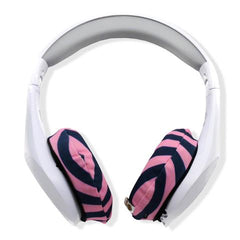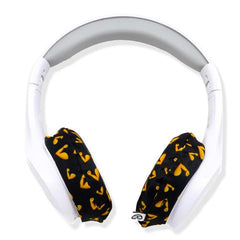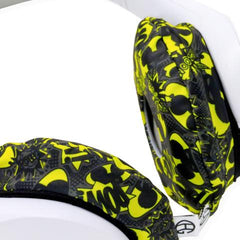On-Ear or Over-Ear Headphones for Working Out?

There’s no right answer here.
Whether you prefer working out in on-ear or over-ear headphones comes down to personal choice; it’s about finding out what best serves you and your workout.
What’s the Difference Between On-Ear and Over-Ear Headphones?
On-ear headphones have smaller cups. They sit ‘on’ the ear rather than covering it completely. This gives them greater portability but makes them less proficient at isolating sound. Although, if you’re working out with on-ear headphones, it’s probably safer to be aware of what's happening around you. An example of an on-ear headphone would be the Beats Solo3 wireless headphone.
You might also see them called supra-aural headphones.

Over-ear headphones have bigger cups that cover the entire ear. You may see them called circumaural. They’re heavier and thicker than an on-ear pair and are, therefore, less portable. Most premium headphone models will be over-ear and these tend to be the choice of audiophiles and those serious about sound quality. Working out with over-ear headphones should offer fewer distractions as they are better noise isolators.
An example of an over-ear headphone would be Bose QuietComfort 35 II headphones.
Before we begin listing the pros and cons of on-ear and over-ear headphones in the gym, it’s worth mentioning that sweat is corrosive and we don’t recommend working out in headphones without first adding a pair of sweat-proof headphone covers. They’re affordable, machine-washable and they come in a range of designs that are all fully reversible to black.
Wearing On-Ear Headphones for Working Out
On-ear headphones are lighter than their over-ear counterparts and that can make all the difference during a workout. The lightweight materials used to manufacture them also mean that they’re easier to carry to and from the gym.
They have an open sound making on-ear headphones safer for working out in. As tempting as it might be to opt for noise-cancelling headphones, it’s usually recommended that you allow for a degree of ambient sound to remain aware of your surroundings at all times. This is especially important if you exercise outdoors.
They won’t feel as hot on the ears as over-ears can and that’s a bonus during intense exercises where your body temperature will be higher.
One thing that makes on-ear headphones tempting is that they’re available at a number of different price points. You can spend hundreds of pounds or dollars on a high-end pair or you can spend less than fifty. It’ll entirely depend on what you want out of them. This makes them both versatile and affordable and, in fitness environments, an especially attractive option.
The disadvantage of having such an open sound for on-ear headphones is that there’ll always be some degree of sound leakage. This is when noise escapes from the headphone and can be heard by those not wearing them. There’s an argument, too, that when headphones aren’t great at blocking sound, the listener is more likely to turn up the volume. Earlier this year, the World Health Organisation released a report suggesting that headphone noise was a danger to public health as it can lead to permanent hearing loss.
On-ear headphones can feel uncomfortable if you wear them for extended periods of time. This is especially true if cheaper padding has been used on the ear cups.
Wearing Over-Ear Headphones for Working Out
Generally speaking, over-ear headphones tend to have a more comfortable fit because they don’t press down on the ear and they’re often very well padded. You should be able to wear them comfortably for extended periods of time making them ideal for those long-ass gym sessions where all you want to think about is form rather than how tight your cans are.
Over-ear headphones have good noise isolation - even those without Active Noise Cancelling technology will keep out a good amount of background noise. Look for headphones that form a good seal over the ear.
Over-ear headphones are known for their sound quality. They have bigger drivers that sit close to the ear. You get a more consistent quality of sound. If you’re an audiophile - someone who’s passionate about hi-fidelity sound - then you’ll probably be happiest with an over-ear headphone.
Over-ear headphones can be more functional and can often include additional technology that could assist you outside the gym. For example, The Sony WH1000XM3 has Google Assistant and can access its real-time Google Translate feature.
We’ve all worked out at some point in the gym to the sound of someone’s massive grunting. It’s hardly conducive to our own concentration when there’s so much unwanted ambient sound around us. That’s when active noise-cancelling technology (ANC) comes into its own in the gym and is included in a number of premium brand over-ear headphones.
There’s a good choice between open and closed backs with over-ear headphones.
An open back helps music sound more natural as air can pass through the headphone. Sound isolation isn’t as good with an open-back but when you’re working out this could be safer as it allows the noise around you to bleed through.
Closed-back headphones offer a sound that’s less natural but that’s better isolated from the world outside. If you’re hoping that music will improve your form, then closed-back headphones - where you’re almost entirely free from distractions - could help enormously.
There’s poorer portability to over-ear headphones: they’re bulky and they're not ideal for travelling with. You’d have to ask yourself how much of a pain it would be to take them to the gym each time.
If there’s a poor seal between the ear and the headphone, then you’ll get sound leakage and as the driver is bigger in these cans, you might end up pissing off the people around you. It’s worth trying on headphones before you buy a pair to make sure there’s a comfortable and consistent seal.
There’s a definite concern that wearing over-ear headphones outside or in the gym makes you less aware of your surroundings and that can be dangerous.
Over-ear headphones can be expensive - really expensive. It’s worth doing your research in order to pick out the one that best suits your needs. This might mean spending a lot but equally, it might not.
Over-ear headphones can feel hot on your ears. If you’re wearing a closed-back headphone, then this can make you sweat even if you’re not exercising that hard. One way around this is to add a pair of sweat-resistant headphone covers. It’s the ideal way, too, to accessorize and personalise your headphones without having to change them.










